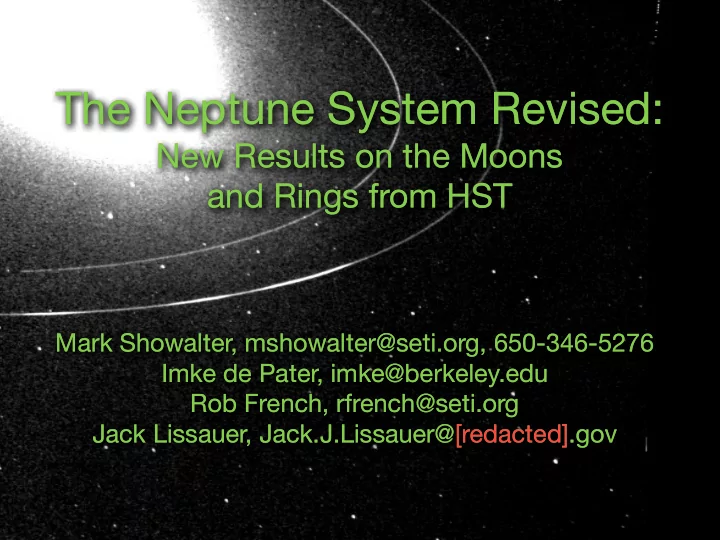

The Neptune System Revised: The Neptune System Revised: New Results on the Moons New Results on the Moons and Rings from HST and Rings from HST Mark Showalter, mshowalter@seti.org, 650-346-5276 Mark Showalter, mshowalter@seti.org, 650-346-5276 Imke de Pater, imke@berkeley.edu Imke de Pater, imke@berkeley.edu Rob French, rfrench@seti.org Rob French, rfrench@seti.org Jack Lissauer, Jack.J.Lissauer@[redacted].gov Jack Lissauer, Jack.J.Lissauer@[redacted].gov
WFC3/UVIS August 19, 2009 8 images 5-minute exposures
Unprocessed Image Unprocessed Image
Filtered for Glare & Artifacts
Filtered for Glare & Artifacts Larissa Despina Galatea
Eight Images Added Larissa Despina Galatea
Question: How do we turn eight 5-minute exposures into one 40-minute exposure?
Question: How do we turn eight 5-minute Question: How do we turn eight 5-minute exposures into one 40-minute exposure? exposures into one 40-minute exposure?
Answer: Distort each image to compensate Answer: Distort each image to compensate for the orbital motion. for the orbital motion.
Answer: Distort each image to compensate Answer: Distort each image to compensate for the orbital motion. for the orbital motion.
Answer: Distort each image to compensate Answer: Distort each image to compensate for the orbital motion. for the orbital motion.
Answer: Distort each image to compensate Answer: Distort each image to compensate for the orbital motion. for the orbital motion. Image 1
Answer: Distort each image to compensate Answer: Distort each image to compensate for the orbital motion. for the orbital motion. Image 2
Answer: Distort each image to compensate Answer: Distort each image to compensate for the orbital motion. for the orbital motion. Image 3
Answer: Distort each image to compensate Answer: Distort each image to compensate for the orbital motion. for the orbital motion. Image 4
Answer: Distort each image to compensate Answer: Distort each image to compensate for the orbital motion. for the orbital motion. Image 5
Answer: Distort each image to compensate Answer: Distort each image to compensate for the orbital motion. for the orbital motion. Image 6
Answer: Distort each image to compensate Answer: Distort each image to compensate for the orbital motion. for the orbital motion. Image 7
Answer: Distort each image to compensate Answer: Distort each image to compensate for the orbital motion. for the orbital motion. Image 8
...and then add them.
...and then add them. ...and then add them. Thalassa S/2004 N 1 Objects too faint to be seen Objects too faint to be seen discovery in a single exposure appear! in a single exposure appear!
ACS/HRC December 8, 2004 8 images Naiad The recovery of Naiad
Neptune’s Inner Satellite System Proteus Despina Galatea x Larissa Naiad Thalassa S/2004 N 1
ACS/HRC Neptune’s Inner Satellite System December 8, 2004 8 images Proteus Despina Galatea x Larissa found Thalassa S/2004 N 1 x predicted Naiad is ahead of its prediction by 80°
Neptune’s Rings and Arcs
Neptune’s Rings and Arcs Leverrier Ring Adams Ring Arcs
All of Neptune’s Arcs Seem to be Fading Voyager 1989 HST 2005 Integrated Intensity (m) HST 2009 Orbital longitude (°)
Summary • We have a processing technique capable of revealing new objects in old HST data. • Naiad has been seen for the first time from Earth. • What’s up with its orbit? (1) Long-term orbital interactions? (interesting!) (2) Standard orbital uncertainties? (not so much) • We have the first visual light detections of the arcs, suitable for quantitative comparison with Voyager. • One arc is gone completely; the other two are fading. • We now have TWO dynamical problems: (1) What confines the arcs? (2) Why isn’t it working? (...for periods of decades.) Mark Showalter, SETI Institute, mshowalter@seti.org, 650-346-5276
Recommend
More recommend